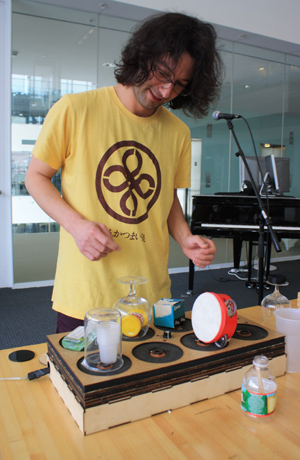MIT Museum Showcases Student Inventions
Exhibit offers a glimpse of the future

Imagine a vine of plump, crimson tomatoes flourishing on your kitchen counter without sunlight and soil. Picture a tiny data-gathering drone that can be folded up and launched from aircraft flare dispensers. No, these aren’t fantasies borrowed from The Jetsons or the Harry Potter franchise. They’re just two of the student inventions currently on view at the MIT Museum in a special exhibit titled Inventions: 2014 Student Showcase. Most of the projects were created by MIT students as part of their coursework, but some were created just for fun. The show, which runs through December 31, offers a tantalizing peek into the future.
Jennifer Broutin Farah’s SproutsIO, is a smartphone-controlled appliance that acts as an indoor microfarm. Strawberries, heirloom tomatoes, and crisp lettuce thrive in an environment that foregoes soil for a nutrient-rich mist. Broutin Farah says the idea for the project was inspired by her love of gardening with her mother. SproutsIO has evolved into a start-up based in Cambridge and, if it succeeds, could make urban gardeners out of the millions of city dwellers with no access to a patch of dirt.
Meanwhile, Paloma Gonzalez Rojas, a student at MIT’s School of Architecture + Planning, has created an interactive display called WalkAcross that shows visitors’ locations and movements in a part of the museum in real time.
Music inspired other inventions in the show. The musical laser harp, the result of various student collaborations at MIT’s Edgerton Center, is a three-dimensional harp with laser beams in lieu of strings and the MIT seal engraved on the playing surface. Visitors can “pluck” the instrument by disrupting the lasers with their fingers, which sends signals to a built-in synthesizer that plays the corresponding musical notes. Meanwhile, Akito van Troyer’s DrumTop turns everyday objects into musical instruments via a tabletop interface that causes the objects to vibrate and emit unique sounds.

In addition to the 11 inventions on display, the exhibit also includes seven kinetic sculptures made by MIT students for their Exhibiting Science class, taught by MIT Museum Director John Durant and MIT Museum Studio codirectors Seth Riskin and Allan Doyle. Students used a variety of materials—everything from bamboo to rubber bands—to create sculptures that use movement to convey a particular feeling.
The MIT Museum has a number of other noteworthy exhibits, including 5000 Moving Parts, a showcase of contemporary kinetic sculpture that explores the intersection of art and engineering. The large-scale works utilize motors, magnets, and even microprocessors to breathe life into the inanimate in hypnotic ways. Another exhibit, Robots & Beyond, showcases the ideas, research, and processes behind artificial intelligence design. For a complete list of current exhibitions, click here.
The MIT Museum, located at 265 Massachusetts Avenue, Central Square, Cambridge, is open daily from 10 a.m. to 5 p.m. Phone: 617-253-5927. Admission is $10 for adults; $5 for youth under 18, students, and seniors; and free for children under 5 or MIT ID card holders. To get there via public transportation, take any inbound Green Line trolley to Hynes Station. Walk to Newbury Street and Massachusetts Avenue and take a #1 bus toward Harvard Station. Get off at Sidney Street and walk three minutes to the museum.
Paula Sokolska can be reached at ps5642@bu.edu.
Comments & Discussion
Boston University moderates comments to facilitate an informed, substantive, civil conversation. Abusive, profane, self-promotional, misleading, incoherent or off-topic comments will be rejected. Moderators are staffed during regular business hours (EST) and can only accept comments written in English. Statistics or facts must include a citation or a link to the citation.